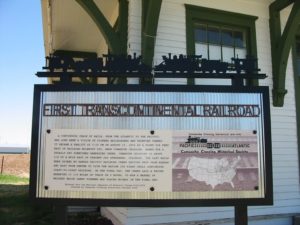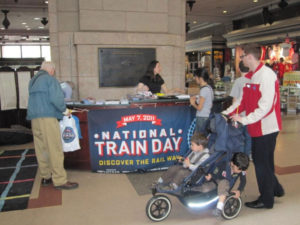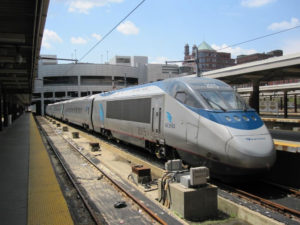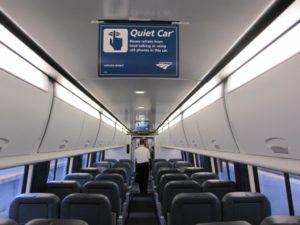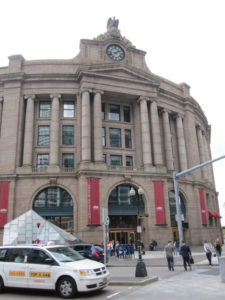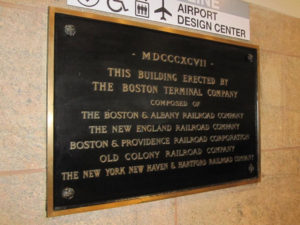National Train Day
05.16.2011 | HMMH |by Dave Towers
There are a number of holidays that occur in early May including May Day, a traditional spring festival celebrated on May 1, and Cinco de Mayo, celebrating Mexican heritage and pride on May 5. In addition, a colleague recently informed me that the day prior to Cinco de Mayo is celebrated as National Star Wars Day: May the 4th be with you! However, for railfans and those who work on projects in the rail industry, the most notable holiday during this period is National Train Day.
National Train Day is a holiday started by Amtrak in 2008 as a means to spread information to the general public about the advantages of rail travel and the history of trains in the United States. Since then, it has been held each year on the Saturday closest to May 10th, the anniversary of the pounding of the Golden Spike at Promontory Summit in Utah (not Promontory Point as often misstated) which marked the completion of what is generally considered the first transcontinental railroad.
Although the joining of the Central Pacific and Union Pacific railroads was a grand achievement, the claim of being “first” needs to be qualified, as one could not yet ride rails without interruption between the Atlantic and Pacific on May 10, 1869. There was a 1,500-foot gap across the Missouri River between Omaha, Nebraska and Council Bluffs, Iowa, and another gap between Sacramento and Oakland, California. While the California gap on the Central Pacific was closed a few months later, the Union Pacific did not complete its permanent bridge across the Missouri River at Omaha until March 22, 1872. In the meantime, transcontinental rail service on the Kansas Pacific Railway via its bridge at Kansas City was achieved when the final spike was driven at Comanche Crossing, Colorado on August 15, 1870, marking the completion of the first uninterrupted transcontinental railroad between the Atlantic and Pacific oceans.
In any case, National Train Day was celebrated this year (in conjunction with Amtrak’s 40th Anniversary) on Saturday May 7, with train equipment displays and events at several of the major stations across the Amtrak system. As a representative of the Rail Group at HMMH, I decided to attend the local festivities at South Station in Boston. The attractions included a jazz trio concert, a display of an Amtrak Acela train, tours of South Station and various informational tables with souvenir items.
The Acela is the first and only “high-speed” train in the U.S. and has been operating on the Northeast Corridor between Boston, MA and Washington, DC since December of 2000. The train travels at speeds of up to 150 mph (240 km/h) for brief intervals, but its average speed is much less due to the many curves in the track; not exactly high speed by European and Asian standards. One popular feature of the Acela introduced by Amtrak is the “Quiet Car” which provides a quiet refuge for train travelers that is especially appreciated by those of us in the noise control field. This concept has spread to several U.S. commuter rail systems, including those in Philadelphia, New Jersey and Boston, where it has been very well received.
I capped off my visit with a guided tour of Boston South Station. Although the tour was limited to public station areas (not a behind-the scenes tour), the guide did provide some interesting information. The station was constructed in 1897 as a “union station,” consolidating several existing railroad lines, and became the busiest station in the country by 1910. As this area of Boston was originally under water, the station is supported by 36,000 piles, one of which is exposed and visible in the passageway between the railroad terminal and the MBTA Red Line subway. By the 1970s the condition of the station had deteriorated significantly, but the station was modernized and restored to its former grandeur in the 1980s as part of the Northeast Corridor Improvement Project. Although the original mechanical train board (sold on Ebay) has been replaced by an electronic one, the clacking sound that occurred during train information updates has been retained.
All in all, participation in National Train Day was a meaningful way to spend a Saturday afternoon. Unfortunately, given the current economic and political conditions, the future of high-speed and other forms of rail transit is somewhat clouded. However, considering the many benefits of passenger rail transportation to the public and to our environment, it can only be hoped that these types of events will help to keep the dream alive.






